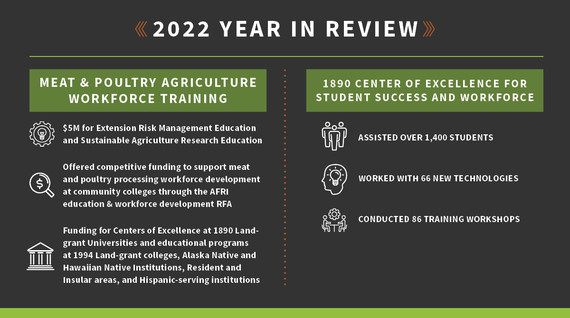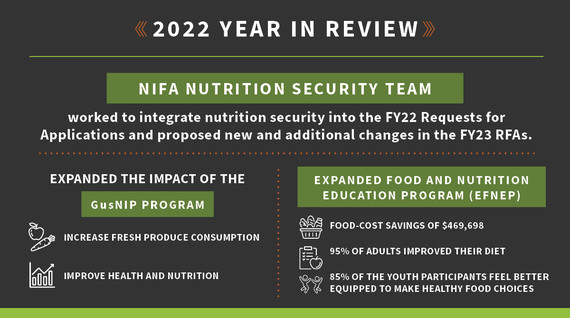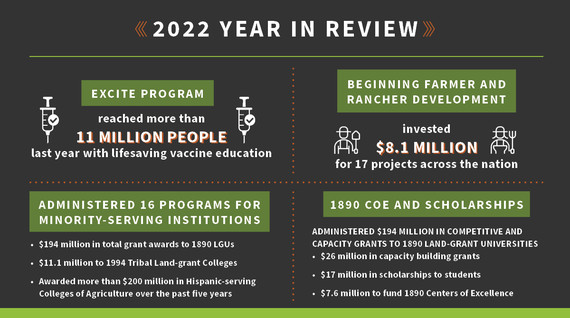|
Having trouble viewing this email? View it as a Web page.

|
|
|
Editor: Maggie Lawrence December 21, 2022
Reflecting on the Successes of 2022

With the final days of 2022 speeding by, we at NIFA are taking time to celebrate this year’s accomplishments even as we are making plans for our work in the coming year. I want to share with you a few highlights of the past year and what we have accomplished. Many of our successes are your successes as well since our close working relationship with our partners is key to achieving NIFA’s goals.
In 2022, NIFA continued its growth as a strong, vibrant and agile agency. Even as we worked to enhance existing programs, NIFA professionals managed an influx of new funds supporting the American Rescue Plan, the Infrastructure Investment and Jobs Act and the Inflation Reduction Act.
NIFA is proud to work with you on important efforts that generate scientific discovery, strengthen education and expand Extension outreach efforts to propel U.S. agriculture forward and solve some of our nation’s most critical challenges.
Thank you for your partnership and dedication to NIFA’s mission. I look forward to working with you in 2023 as we tackle national priorities and work to find solutions for the benefit of all.
Finally, as we approach a time when many traditions are celebrated, I offer best wishes and a hope you will take time to rest and recharge and spend time with your families and the people most important to you.
Dr. Dionne Toombs,
Acting Director of NIFA
|
|
|


- Awarded almost $2.2 billion in grant funds in Fiscal Year 2022.
- Supported USDA’s Strategic Goals
- Investing in climate resilience and U.S. agriculture’s ability to be part of the climate solution.
- Prioritizing consistent access to safe, nutritious food for all Americans.
- Developing more and better markets for U.S. agricultural producers.
- Building stronger rural economies.
- Ensuring underserved groups can more fully access and participate in USDA programs and services.

- Managed new funds totaling almost one-third of the NIFA budget.
- Funding sources
- American Rescue Plan Act
- Infrastructure Investment and Jobs Act
- Inflation Reduction Act

- Implemented Bioproduct Pilot Program to support research studying the benefits of using materials derived from covered agricultural commodities to manufacture construction and consumer products. Increasing production, distribution and sale of biobased products will spur growth in rural economies while reducing the risks of bringing biobased products to the market. Additionally, it will help foster a circular economy where resources can be extracted, consumed and reused in a sustainable manner.
- Added a new program area priority to the AFRI Foundational and Applied Science Request for Applications (RFA) to spur development and implementation of climate-smart agricultural or forestry practices that will reduce greenhouse gas emissions and create positive economic, environmental and social impacts.
- Released an updated Climate Adaptation and Resilience Plan, outlining how NIFA will combat climate change and its threat to U.S. food and agriculture. Implementation is currently underway and includes program changes and attention to environmental justice.
- Achieved a significant milestone in the Small Business Innovation Research (SBIR) program. Extramural research expenditures for research and development activities reached $1 billion, mandating the creation of a new parallel effort, the Small Business Technology Transfer (STTR) program. Both SBIR and STTR programs are focused on developing innovative solutions to pressing problems that can then be commercialized as new products and services or as improvements to existing ones.

- Strengthened the infrastructure and shored up the nation’s food supply chain – especially in meat and poultry production and processing via American Rescue Plan Meat & Poultry Agriculture Workforce Training program. These investments will enhance equity and capacity across the food supply chain by supporting meat and poultry research, education and training at the local level. Workforce training will increase the resiliency and competitiveness of local and regional supply chains and support the industry’s urgent need for highly skilled talent to meet labor demands across the country.
- Provided $5 million for Extension Risk Management Education and Sustainable Agriculture Research Education. These programs will support development of meat and poultry processing training and educational materials for place-based needs, particularly relevant to small- or medium-sized farmers and ranchers.
- Offered competitive funding to support meat and poultry processing workforce development at community colleges through the AFRI Education & Workforce Development RFA.
- Established funding for Centers of Excellence at 1890 Land-grant Universities and educational programs at 1994 Land-grant Colleges, Alaska Native and Hawaiian Native Institutions, Resident and Insular Areas, and Hispanic-serving Institutions to develop or enhance existing meat and poultry processing training programs. This funding is critical to our and our partners’ efforts to prepare students for careers in the food, agriculture and natural resources sciences.
- Assisted more than 1,400 students, worked with 66 new technologies, and conducted 86 training workshops through these centers.

- Mobilized an agency-wide NIFA Nutrition Security Team that includes more than 80 staff. This team coordinates and promotes NIFA’s more than $200 million investments in research, education, Extension, and innovation to advance USDA’s goal to tackle food and nutrition insecurity.
- Within AFRI
- Added nutrition to the AFRI Extension, Education, and USDA Climate Hubs Partnership (A1721).
- Improved integration of nutrition security into the AFRI Sustainable Agricultural Systems (A9201) and ensuring a better dissemination of this RFA among key climate and nutrition communities.
- Assisted with the integration of nutrition security into the AFRI rapid response (A1712) extreme weather events across food and agriculture.
- Reviewed other AFRI priority areas in plant and animal systems to integrate a consistent nutrition security perspective.
-
- Used Outside of AFRI
- Used American Rescue Plan funding to expand the impact of the Gus Schumacher Nutrition Incentive Program (GusNIP) to increase consumption of fresh produce and improve health and nutrition in low-resource communities.
-
- Distributed up to $40 million through GusNIP grants and program enhancements. Participants redeemed more than $20 million in nutrition incentives and reported increased fruit and vegetable intake and improvements in food security.
- Provided education and training for underserved communities through NIFA’s Expanded Food and Nutrition Education Program (EFNEP). EFNEP is the nation’s first nutrition education program for low-income populations and remains at the forefront of nutrition education efforts to reduce nutrition insecurity of low-income families and youths today.

- Reached more than 11 million people through the EXCITE program, a cooperative agreement between NIFA, the Centers for Disease Control and Prevention and the Cooperative Extension System to deliver vaccine education to hard-to-reach communities across the nation. EXCITE projects were active in almost every state as well as on 17 different Native American reservations. These projects were specifically focused on reaching rural and medically underserved communities. Partnerships to enhance community trust, outreach, and communication were a critical element of Excite projects.
- Second round of funding has expanded the program to focus LGU Vaccine Confidence and Adult Immunization Confidence.
- Invested $8.1 million for 17 Beginning Farmer and Rancher Development projects in the last fiscal year. Strengthening and growing the pipeline of the next generation of farmers and ranchers is vital to the continued success of American agriculture. Beginning farmers and ranchers have unique needs for education, training and technical assistance. Their success often hinges on access to reliable, science-based information and the latest educational resources so they can improve their operations’ profitability and sustainability long-term.
- Administered multiple programs specifically for Minority-serving Institutions (MSIs) which facilitate rural prosperity and economic development. Additionally, NIFA-supported research at MSIs has led to scientific breakthroughs benefiting minority farmers, stakeholders of the 1890 LGUs and the nation as a whole, while scholarships and other student-focused programs are ensuring outstanding students at MSIs can pursue and complete degrees in the food and agricultural sciences and related fields.
- Broadened opportunities with the “From Learning to Leading: Cultivating the Next Generation of Diverse Food and Agriculture Professionals” program to create career development opportunities for students at MSIs through a $250 million investment.
- Oversaw $194 million in competitive and capacity grants to 1890 Land-grant Universities.
- $26 million in capacity building grants
- $17 million in student scholarships
- $7.6 million to fund 1890 Centers of Excellence
- Invested more than $15 million in Centers of Excellence at 1890 Institutions, funding six collaborative research centers focused on subjects ranging from rural prosperity and climate-smart technology to food security, health, and nutrition. These investments will strengthen efforts at various Historically Black Colleges and Universities in developing research, workforce development and Extension programs that support underserved producers and the communities they serve.
- Provided more than $4 million in funds through the New Beginning for Tribal Students program. The New Beginnings program supports 1994 Institutions and Tribal students in diverse ways including dual credit programs; tuition and related fees; experiential learning; and student services, including tutoring; counseling; academic advising. The program’s overarching goal is to increase the retention and graduation rate of Tribal students.
- Allocated about $7.5 million in funds to the Tribal Colleges Research Grant Program. The Tribal College Research Grant Program helps 1994 Land-Grants become centers of scientific inquiry and learning for remote and rural reservation communities. This funding helps them address important questions impacting their communities. Additionally, the program emphasizes training students in science and enhancing both students’ career opportunities and economic vitality in their communities.
- Made available about $12 million through the Hispanic-Serving Institutions Education Grants Program. These monies funded projects at institutions in multiple states to deliver education and training in agricultural disciplines ranging from food and nutrition to climate-smart technologies.
|
|
|
NIFA’s mission is to invest in and advance agricultural research, education, and Extension that solves societal challenges. NIFA’s investments in transformative science directly support the long-term prosperity and global preeminence of U.S. agriculture. Keep informed about NIFA, USDA, our Land-grant and non-Land-grant university partners, and stakeholders with the NIFA Update. Read past issues online, sign up for email updates or follow us on Twitter @USDA_NIFA, #NIFAImpacts or LinkedIn @usda-nifa.
If you wish to submit a news item or information, send an email to NIFAUpdate.
USDA is an equal opportunity lender, provider, and employer.
|
|
|
|